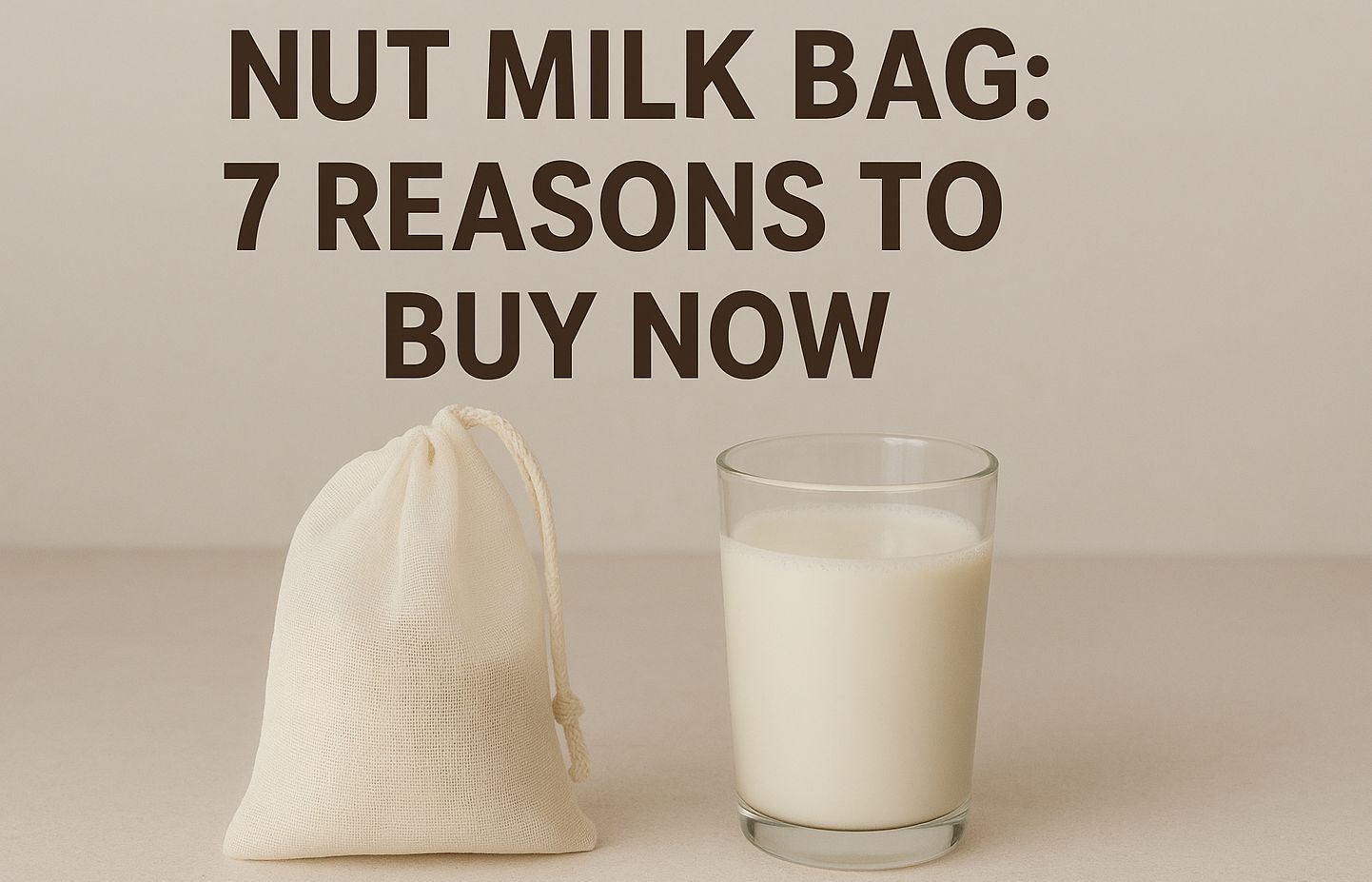Table of Contents
Nut Milk Bag from the past decade, plant-based diets have taken the world by storm. From almond milk to oat milk, people are switching to dairy-free alternatives for better health, taste, and sustainability. But behind every creamy, frothy batch of homemade nut milk, there’s a secret tool that makes all the difference — the nut milk bag.
Whether you’re making almond milk, coconut milk, or cold brew coffee, a nut milk bag is a simple yet game-changing kitchen essential. Let’s explore what it is, why you need one, and how to use and care for it the right way.
What Is a Nut Milk Bag?
A nut milk bag is a fine mesh or cloth bag used to strain blended nuts, seeds, or oats to make smooth, creamy plant-based milk at home. Think of it as a reusable alternative to cheesecloth, but sturdier and easier to clean.
Typically made from nylon, cotton, or hemp, these bags feature a tight weave that keeps pulp out while allowing liquid to pass through. The result? Perfectly smooth almond milk, cashew milk, or any plant-based beverage you love.
In short, a nut milk bag acts as your personal “mini filter press” for homemade dairy-free drinks, juices, or even cold brew coffee.
Why Every Kitchen Needs a Nut Milk Bag
If you’ve ever tried making nut milk without one, you probably know the struggle—lumpy texture, bits of pulp, and messy cleanup. Here’s why a nut milk bag is a must-have:
- Smooth Texture: It filters out pulp better than traditional sieves or cloths.
- Reusable: Eco-friendly and sustainable, reducing single-use waste.
- Multi-purpose: Perfect for juicing, straining yogurt, or even sprouting nuts.
- Cost-effective: Saves money versus buying store-bought plant milks.
- Easy to Clean: A quick rinse and you’re ready for your next batch.
- Durable Materials: Quality nut milk bags last for years with proper care.
- Better Flavor: Straining with a bag brings out the pure, creamy taste of your ingredients.
How to Use a Nut Milk Bag
Making nut milk is surprisingly easy once you have the right tools. Here’s a simple step-by-step process:
- Soak the Nuts – Place 1 cup of almonds, cashews, or your choice of nuts in water overnight.
- Blend – Drain and blend with 3–4 cups of fresh water until smooth.
- Strain – Place the nut milk bag over a large bowl or jug and pour the blended mixture inside.
- Squeeze – Gently twist and squeeze the bag to extract all the milk.
- Store – Pour the milk into a sealed container and refrigerate for up to 4 days.
That’s it! You’ve got fresh, preservative-free, dairy-free milk ready to enjoy.
How to Clean a Nut Milk Bag
One of the most common questions is: how to clean a nut milk bag properly? Cleaning is simple, but doing it right ensures the bag stays fresh and mold-free.
- Rinse Immediately: Right after use, rinse the bag thoroughly with cold water to remove any residue.
- Soak in Warm Soapy Water: Fill a bowl with warm water and a few drops of natural dish soap. Let the bag soak for 5–10 minutes.
- Massage Gently: Rub the fabric between your fingers to loosen any pulp stuck in the mesh.
- Rinse Again: Rinse thoroughly until all soap is gone.
- Air Dry: Hang it up or drape it over a bottle or faucet to air dry completely.
Pro Tip: Avoid using hot water or harsh detergents, as they can damage the fibers or cause odor buildup.
Where to Buy a Nut Milk Bag
If you’re wondering where to buy nut milk bag options, the good news is — they’re widely available both online and in stores.
You can find quality nut milk bags at:
- Amazon – Offers a wide range from organic cotton to fine nylon mesh.
- Walmart & Target – Affordable multi-pack options in their kitchenware aisles.
- Whole Foods Market – Great for eco-friendly, sustainable versions.
- Etsy – Handmade hemp or cotton varieties for zero-waste enthusiasts.
- Specialty Health Stores – Local organic markets often carry reusable nut milk bags.
Where Can I Buy a Nut Milk Bag Near Me?
If you prefer to shop in person, most health food stores, organic markets, or kitchen supply stores sell nut milk bags. Simply look in the section for juicing, sprouting, or eco-kitchen products.
Many stores like Bed Bath & Beyond, Sprouts, or The Vitamin Shoppe now carry reusable kitchen filters and strainers designed specifically for plant-based milks.
How to Make Almond Milk Without a Nut Bag
Don’t have a nut milk bag yet? No worries — you can still make almond milk at home using a few alternatives.
Here’s how:
- Use a Fine Mesh Sieve: Line it with a clean dish towel or cheesecloth to strain your almond mixture.
- Use a French Press: Pour the blended almonds into your French press and press slowly to filter.
- Use a Clean T-Shirt or Coffee Filter: In a pinch, these can work too — just ensure they’re clean and free of detergent smell.
While these methods work temporarily, they’re not as efficient or clean as a proper nut milk bag. Investing in one will make your almond milk smoother and your process much easier.
Creative Ways to Use a Nut Milk Bag Beyond Plant Milk
A nut milk bag isn’t just for milk! Here are a few creative uses you’ll love:
- Cold Brew Coffee: Steep ground coffee in water and strain with your bag for smooth cold brew.
- Homemade Juices: Strain blended fruits and veggies for clear, pulp-free juice.
- Yogurt Making: Strain homemade yogurt for Greek-style thickness.
- Cheese Making: Use for straining soft vegan or dairy cheeses.
- Sprouting: Some bags double as sprouting pouches for beans or lentils.
This versatility makes a nut milk bag one of the most underrated tools in a sustainable kitchen.
Eco-Friendly Benefits of Using a Nut Milk Bag
Besides saving money, switching to a nut milk bag reduces environmental waste. Store-bought nut milks often come in non-recyclable cartons and contain preservatives or gums. By making your own:
- You control the ingredients
- You reduce packaging waste
- You reuse the same bag for years
- You avoid additives and artificial flavors
It’s a small change that makes a big impact — for your health and the planet.
Choosing the Right Nut Milk Bag
When buying a nut milk bag, here’s what to look for:
- Material: Choose between nylon (durable, fine mesh), cotton (natural, soft), or hemp (eco-friendly).
- Shape & Size: Large square or rounded bags make straining easier.
- Stitching Quality: Double-stitched seams prevent tearing under pressure.
- Ease of Cleaning: Nylon and hemp tend to dry faster and resist odors.
Brands like Ellie’s Best, EcoPeaceful, and Bellamei are popular for their quality and longevity.
Final Thoughts: A Small Tool with a Big Impact
A nut milk bag may seem like a small addition to your kitchen, but its impact is huge. It empowers you to take control of your ingredients, live more sustainably, and enjoy fresher, healthier plant-based milks and juices at home.
From cleaning tips to creative uses, investing in a good-quality nut milk bag is one of the smartest and most affordable steps toward a greener lifestyle. So go ahead — soak, blend, strain, and sip your way to healthier mornings!
FAQs
Q1: What is a nut milk bag used for?
A nut milk bag is used to strain blended nuts, seeds, or oats to create smooth, creamy plant-based milk.
Q2: How to clean a nut milk bag?
Rinse immediately after use, soak in warm soapy water, gently massage, rinse thoroughly, and air dry.
Q3: Where can I buy a nut milk bag?
You can buy them online on Amazon, Walmart, or at local organic and kitchen supply stores.
Q4: Where to buy nut milk bag near me?
Check health food stores, Whole Foods, Sprouts, or local zero-waste shops.
Q5: How to make almond milk without a nut bag?
Use a fine mesh strainer, cheesecloth, French press, or even a clean T-shirt to strain the milk if you don’t have a nut milk bag.



